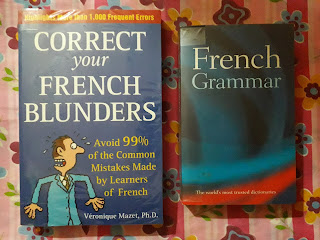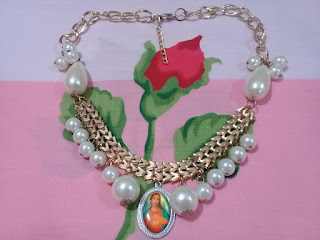To me, French is the most beautiful language in the world. But why French? Because it keeps drawing me closer to Lourdes, to the Grotto of Massabielle, the place where the Virgin Mary appeared 18 times to St. Bernadette from 11 Feb to 16 July 1858 (Please click here to read more about the Grotto of Massabielle). Massabielle Grotto is the heart of the Lourdes shrine. It is a place for silent contemplation and the silent, private joy of personal prayer that Bernadette experienced during the first apparitions is today shared by all those who come to pray at the grotto. It was at the Grotto of Massabielle that I spent many hours in the evenings waiting for the sunset. I feel very peaceful each time I read a French book because the language reminds me of Lourdes, especially of those peaceful moments when I sat in front of the Grotto of Massabielle praying and waiting for the sunset. Although I learned French because of my love for Lourdes, I feel glad that I am able to speak French because it is a major language of international communication and the second global language in the world, after English.
Frankly speaking, I have never attended any French lessons because I don't like to go for classes. As a daydreamer, I would only dream in class and that was why I preferred to study on my own at home. In this article, I would like to share my French learning experiences and French Language Collection with my readers. My French learning experiences are divided into three stages and these are described in detail below.
THE FIRST STAGE
In the first stage, I focused on simple French conversation, listening, elementary grammar, and vocabulary building.
Collins Easy Learning French Conversation & Get Talking French (audio course) by Jean-Claude Arragon. Communicating effectively in French isn't just about linguistic competence - it's also about cultural knowledge. To feel confident in a French speaking country, it is useful to know more about French culture and lifestyle. Collins Easy Learning French Conversation also provides the necessary information to enable a beginner to gain a deeper insight into the language, the country and its people.
By listening to these specially composed melodies with their rhythmic repetitions of French and English a few times, you can pick up over 200 essential words and phrases that will not just be on the tip of your tongue, but burned deeply into your long-term memory in next to no time. Volume 1 is your survival kit of essential words and phrases to get you by on your trip abroad. Volume 2 will have you talking about yourself, past, present and future, expressing your opinions, and chatting.
Adventures with Nicholas: The Missing Cat (a story-based introduction to learning French) & Berlitz New Basic French. I really enjoyed singing the songs that accompanied the story of the missing cat even though they were a bit childish. Berlitz New Basic French (my first self-study French course) comes with 6 CDs and includes a variety of language building activities, culture and language tips, pronunciation activities, easy-to-understand grammar basics and review exercises.
Adventures with Nicholas - A Visit to Grandma & The Five Crayons. I love my exciting bilingual adventures with Nicholas because I learned a lot from him!
French by Association by Dr. Michael M. Gruneberg - an effective technique for learning and remembering Basic French Vocabulary and grammar. This innovative method can help beginners to remember what they learn. Please click here to read more about this book.
1000 French vocabulary study cards to increase your vocabulary. They really worked for me.
Berlitz French Vocabulary Handbook (with thousands of essential words and expressions covering everyday situations) & Berlitz France Handbook (packed with all the information you need to know about France).
These French visual dictionaries featuring a complete range of illustrated objects and scenes from everyday life provide a quick and intuitive way to learn and remember thousands of French words. A picture is worth a thousand words. When I was a beginner, I used to look at the pictures in these visual dictionaries and they really helped me to pick up thousands of French words in no time.
THE SECOND STAGE
In the second stage, I began to learn French grammar. To become fluent, I had to learn how these language building blocks are used in everyday speech and writing. The only way to build my confidence in French was to practice, practice, practice. That was why I really took the trouble to do the exercises in my grammar books (below).
French Verb Tenses by Trudie Maria Booth & Complete French Grammar by Annie Heminway
French Vocabulary (320 exercises with answers) and French Grammar (578 exercises with answers) by Mary E. Coffman Crocker.
French Grammar by Didier Bertrand and French & English Grammar by C. Frederick Farrell Jr.
French Sentence Builder by Eliane Kurbegov & French Pronouns and Prepositions by Annie Heminway
French Verb Drills by R. de Roussy de Sales & French Verbs for Dummies by Zoe Erotopoulos.
At this stage, the easy to understand Berlitz French Easy Read Dictionary was like a Bible to me because learning French grammar also involved vocabulary learning.
The Ultimate French Review and Practice (mastering French grammar for confident communication) & The Ultimate French Verb Review and Practice (mastering verbs and sentence building for confident communication) by David M. Stillman and Ronni L. Gordon. The Ultimate French Review and Practice (organized into 28 lessons) offers clear, concise explanations of all the grammar topics that intermediate and advanced learners of French ought to know. Each grammatical concept is illustrated with examples that reflect everyday usage.
Berlitz French Verb Handbook (a complete guide to French verbs) & Grammar Handbook (featuring clear and simple explanations on parts of speech, spelling and punctuation, syntax, types of verbs, verb tenses, and conjugations).
Collins Easy Learning French Grammar & French Verbs with thousands of examples to show you the right way to use French grammar / verbs.
Correct Your French Blunders by Veronique Mazet (warns you of hundreds of typical errors learners make and explains the reasons behind the mistakes) & French Grammar by William Rowlinson (where you will find all the basic grammar of French presented clearly, comprehensively, and succinctly).
Essential French Grammar by Jean Severy & 101 French Verbs: The Art of Conjugation by Rory Ryder.
Common French Expressions and Idioms & French Verbs Exercise Book by Jean Severy. Mr Jean Severy is a lecturer in the Department of Asian and European Languages, Faculty of Languages and Linguistics, University Malaya.
French Grammar Drills by Eliane Kurbegov (features more than 150 drills that demonstrate how the French grammar system works, including review exercises to reinforce learning) & Advanced French Grammar by Veronique Mazet. After all the grammar practices, it was time to take my French grammar skills to the next level and tackle more sophisticated sentence constructions with Advanced French Grammar.
THE THIRD STAGE
In the third stage, after mastering French grammar, I began to read dual language books.
I started with 101 French Proverbs and 101 French Idioms by Jean-Marie Cassagne that are packed with mini-dialogues to enrich my French conversation followed by Better Reading French before I began reading the dual language short stories.
Better Reading French by Annie Heminway (a reader and guide to improving your understanding of written French) & Short Stories in French (a dual language book). Better Reading French brings you short passages that reflect real-life, contemporary issues and situations taken from magazines, the Internet, books, and newspapers. Following each article is a set of exercises that help your comprehension and develop invaluable reading skills including (i) skimming and scanning, (ii) using word formation, cognates, and context to determine meaning, & (iii) understanding idioms and artistic expressions.
Best Short Stories by Guy de Maupassant & Selected Fables by Jean de La Fontaine.
French Stories (Ten short stories by Voltaire, Balzac, Gide, Camus and others in the original French and new English translation) & Nineteenth-Century French Short Stories (Stories by Merimee, Nerval, Daudet, Flaubert, Zola, and Maupassant). The short stories really motivated me to read and enjoy what I read.
Collins Robert French Dictionary (complete & unabridged) - my favourite dictionary. At this stage, I don't use visual dictionaries anymore. I want something more professional and, of course, this is the best dictionary for me now. What am I going to read next? The Bible in French. You may also like to read FRENCH GRAMMAR: THE PRESENT TENSE, FRENCH GRAMMAR: THE PAST TENSES, FRENCH GRAMMAR: THE FUTURE TENSE and HOW TO LEARN ENGLISH EFFECTIVELY ON YOUR OWN.







































































